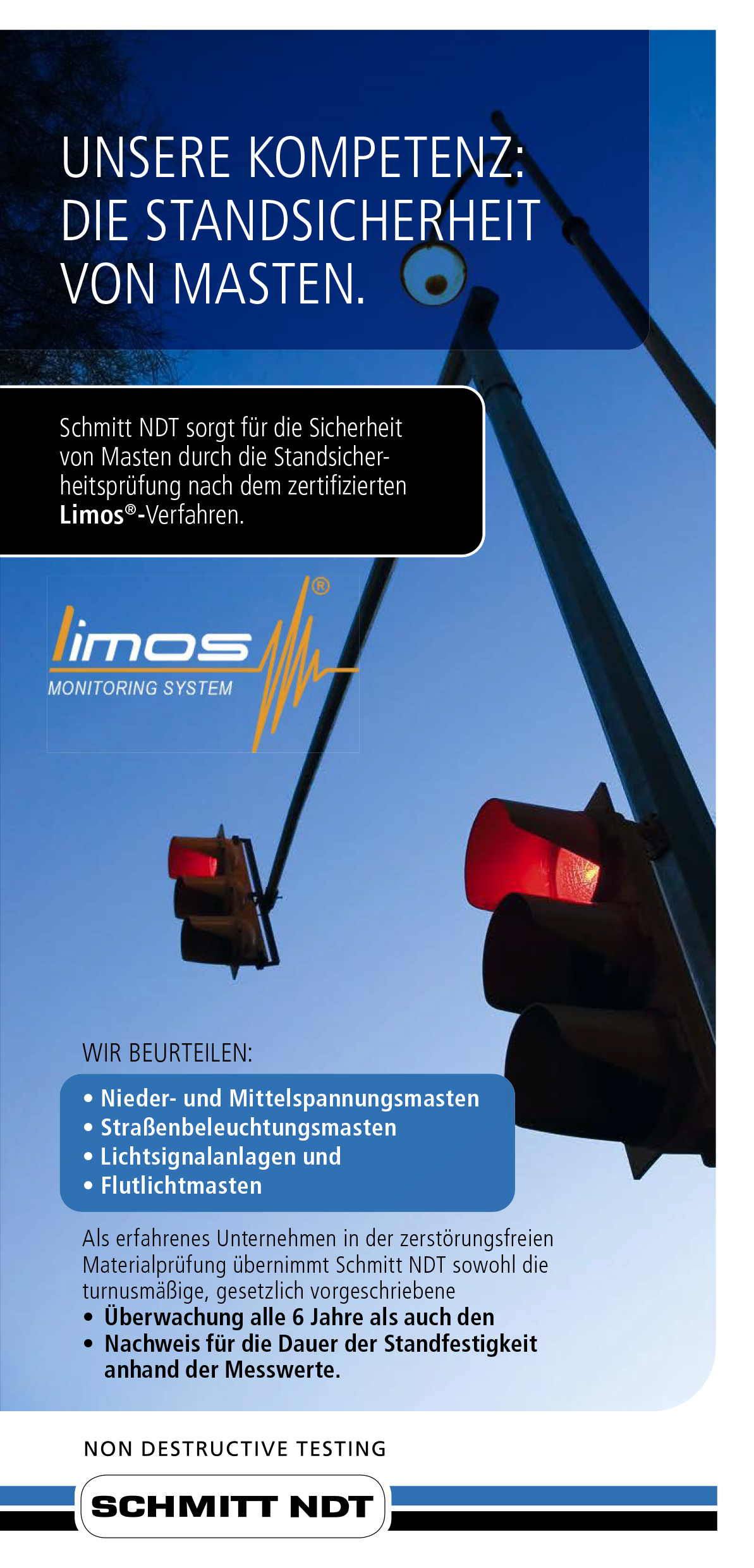EVERYTHING HASITS OWN STORY.
EVERYTHING HASITS OWN STORY.
News
„New paths in the stability testing of masts.“
PRÜFVERFAHREN LIMOS® – TEST METHOD - WORLDWIDE EXPERIENCE FOR 20 YEARS.
COOPERATION WITH VCE/LIMOS®.
The companies Schmitt NDT and VCE have entered into a long-term, strategic partnership for the metrological stability testing of masts, in particular lighting masts, using the Limos® metrological testing method. VCE, an engineering company headquartered in Vienna, has developed the Limos® test method and has been carrying out metrological stability tests on all types of masts worldwide for around 20 years.
SCHMITT NDT IS A PARTNER IN GERMANY.
As a German family business, Schmitt NDT is one of the most experienced providers of non-destructive testing in Germany. In future, Schmitt NDT will offer Limos® as a testing method throughout Germany and carry out on-site stability tests on all types of masts. The relevant cooperation agreement was signed by the management of both companies on 26.04.2024.

Photo left to right: Jan Weitzel (Schmitt NDT), Günther Achs (VCE)
POLE TESTING TEST PROCESS
„There are various test methods.“
THE CURRENTLY MOST MODERN LIMOS STRUCTURAL STABILITY TEST IS NON-DESTRUCTIVE.
THE TEST PROCESS:
The pole is made to oscillate gently and generates an oscillation frequency that is independent of the condition of the base, the pole and the dependent parts. It generates an individual inherent frequency that is determined exactly using an acceleration measuring device and is compared with the prescribed standard values.
The degree of deviation indicates the progress of the damage to the pole. Based on the exact value and on the basis of facts, it can be established exactly how much longer a pole will continue to stand securely, whether and which parts must be replaced or whether the pole needs to be replaced.
MANAGEABLE COSTS:
With regular testing, you keep a handle on your costs, as you can react before damage on poles is irreparable.
TEST REPORTS
„Significant test reports are the basis for the correct decision.“
IF THE POLE HAS A LIMITED LIFESPAN, IT IS POSSIBLE BOTH TO REPLACE IT AND TO REPLACE THE PARTS.
This choice has different financial consequences. The optimal solution is fact-based due to the strength of the frequency deviation of the pole oscillation from the prescribed standard values. This frequency depends on the material condition of the pole and the base.
OUR TEST PROTOCOL THEREFORE INCLUDES:
• The proof of structural stability
• The damage analysis of the material for structural safety and position stability
• The calculational definition of the test interval
• The prognostic lifespan
• The action instruction
THE FOLLOWING ARE RELEVANT TO THE INHERENT FREQUENCY MEASUREMENT:
• Head point displacement
• Horizontal loads (wind)
• Vertical loads (e.g. technical supervisor)
• Rotation in the formation area
• Comparison of the measures inherent frequency with the calculated system rigidity
• Classification of the pole according to applicable standards
REQUIREMENTS
„Would you like an information meeting?“
WE WILL GIVE YOU A COST/BENEFIT ESTIMATE IN ADVANCE.
As a plant operator, you must have the structural stability of your poles examined rotationally at least every six years according to DIN 1076.
• Our experts will test your poles, provide a meaningful test protocol and give you recommendations for necessary test intervals, part-replacements and complete replacements.
THE LEGISLATOR’S REQUIREMENTS:
• Legal duty to maintain safety pursuant to BGB Section 823
• Danger potential liability pursuant to BGB
• Provisions of the trade associations regarding load-bearing systems pursuant to BGV A3 Section 5
POLE LIFESPAN
„How long is the lifespan of poles?“
THE CAREFUL FREQUENCY MEASUREMENT CREATES CLARITY.
As a plant operator, you are responsible for the structural stability of poles of all types as part of your legal duty to maintain safety. Pole safety depends on age and stress.
The Limos® process delivers you reliable measurement results on the condition of the poles as a basis for your decisions and to prove your fulfilment of the operator duties.
ADVANTAGES OF THE STRUCTURAL STABILITY TEST:
You receive a significant measurement result with:
• condition assessment
• assessment of the residual lifespan
• rotational inspection intervals
• damage-free measurement
You avoid unnecessary pole changes and receive the proof of the legal duty to maintain safety.
The sensory measurement processes by means of an inherent frequency measurement saves costs, protects the environment and saves financial resources by doing away with heavy external auxiliary machines and through implementation with only one tester. Additionally, no traffic obstructions arise.
• Proof of structural stability is to be produced before the construction of any structure.
Thereafter, the tests take place on a rotational basis in order to prove complete safety.



